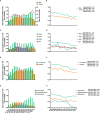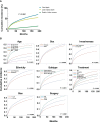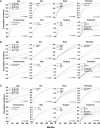Epidemiology and risk stratification of low-grade gliomas in the United States, 2004-2019: A competing-risk regression model for survival analysis
- PMID: 36937393
- PMCID: PMC10014976
- DOI: 10.3389/fonc.2023.1079597
Epidemiology and risk stratification of low-grade gliomas in the United States, 2004-2019: A competing-risk regression model for survival analysis
Abstract
Background: Understanding the epidemiology and prognostic factors of low-grade gliomas (LGGs) can help estimate the public health impact and optimize risk stratification and treatment strategies.
Methods: 3 337 patients diagnosed with LGGs were collected from the Surveillance, Epidemiology, and End Results (SEER) dataset, 2004-2019. The incidence trends of LGGs were analyzed by patient demographics (sex, age, race, and ethnicity). In addition, a competing risk regression model was used to explore the prognostic factors of LGGs by patient demographics, tumor characteristics (histological subtypes, invasiveness, and size), treatment modality, and molecular markers (IDH mutation and 1p/19q codeletion).
Results: LGGs occurred more frequently in male, non-Hispanic, and White populations. The incidence rate of mixed gliomas was stable from 2004 to 2013 and decreased dramatically to nearly zero until 2019. The risk of death increased 1.99 times for every 20-year increase in patient age, and 60 years is a predictive cut-off age for risk stratification of LGGs. Male patients showed poorer LGG-specific survival. Among the different subtypes, astrocytoma has the worst prognosis, followed by mixed glioma and oligodendroglioma. Tumors with larger size (≥5 cm) and invasive behavior tended to have poorer survival. Patients who underwent gross total resection had better survival rates than those who underwent subtotal resection. Among the different treatment modalities, surgery alone had the best survival, followed by surgery + radiotherapy + chemotherapy, but chemotherapy alone had a higher death risk than no treatment. Furthermore, age, invasiveness, and molecular markers were the most robust prognostic factors.
Conclusion: This study reviewed the incidence trends and identified several prognostic factors that help clinicians identify high-risk patients and determine the need for postoperative treatment according to guidelines.
Keywords: SEER Program; incidence; low-grade glioma; molecular marker; risk factor.
Copyright © 2023 Cao, Yan, Zhan, Hong and Yan.
Conflict of interest statement
The authors declare that the research was conducted in the absence of any commercial or financial relationships that could be construed as a potential conflict of interest.
Figures





References
-
- Ostrom QT, de Blank PM, Kruchko C, Petersen CM, Liao P, Finlay JL, et al. . Alex's lemonade stand foundation infant and childhood primary brain and central nervous system tumors diagnosed in the united states in 2007–2011. Neuro-oncology (2014) 16(suppl_10):x1–x36. doi: 10.1093/neuonc/nou327 - DOI - PMC - PubMed
LinkOut - more resources
Full Text Sources

